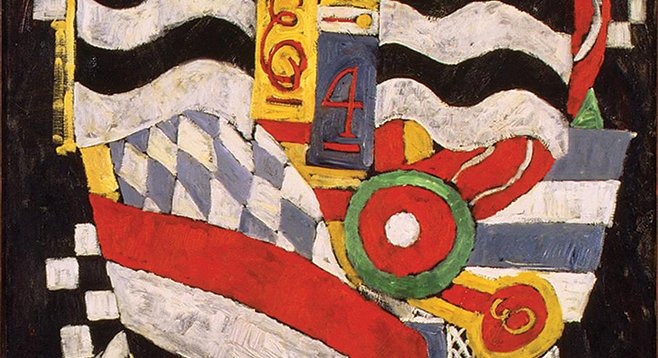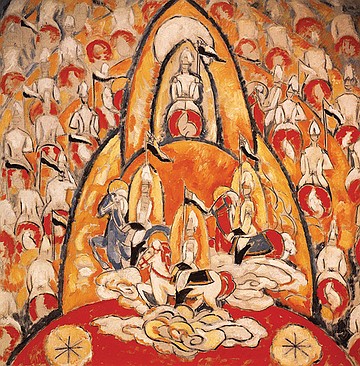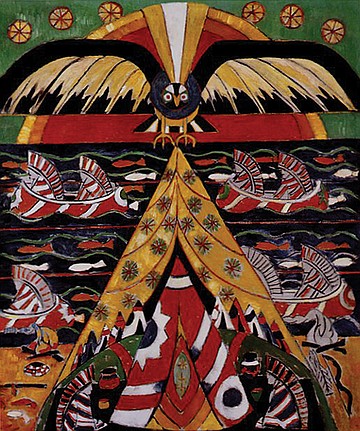 Facebook
Facebook
 X
X
 Instagram
Instagram
 TikTok
TikTok
 Youtube
Youtube

In his 1950s poem “Asphodel, that Greeny Flower,” William Carlos Williams describes a scene where he and a friend, “a distinguished artist,” are standing on a train platform when a freight train thunders through and kicks up dust. It’s what Williams calls “a picture of crude force.” The friend says: “That’s what we’d all like to be, Bill.” The artist is Marsden Hartley, born Edmund Hartley in 1877 in Lewiston, Maine. (In his 20s, Hartley left Edmund behind and took his stepmother’s surname.) He studied art first at the Cleveland Institute of Art, after his family moved to Ohio in 1892, then later at the National Academy of Design in New York. By 1910 he was exhibiting at Alfred Stieglitz’s 291 Gallery and keeping company with other artists — Charles Demuth, Paul Strand, and John Marin, among them — associated with the gallery. He befriended writers and wrote poetry, criticism, and an autobiography. His early pictures are bold, romantic, declarative. The best have the elegant blunt force Hartley admired in that freight train, but this is the same artist who insisted on the spiritual aspirations of his practice. To Stieglitz he wrote: “The essence which is in me is American mysticism.”

Many artists of Hartley’s generation aspired to a freshly American art, a feisty, smashing vernacular informed by European modernism. In New York, Hartley spent a lot of time in the studio of the great American visionary Albert Pinkham Ryder, and the landscapes he made in his 20s are haunted by Ryder. In 1912 he’s on his way to Paris and in 1913 moves to Berlin, where he stays till 1916. He goes back to Europe in 1921 for several years but settles finally in Maine and becomes, like Cézanne, a local painter, a regionalist, and one of our greatest artists. (He died in 1943.) In Berlin he befriended Arnold Rönnebeck, a sculptor, who introduced Hartley to his cousin, Karl von Freyburg. Hartley fell in love with von Freyburg, who was killed in the first months of World War I, and for several years his pictures mourned that loss. (Their recurrent triangular forms memorialize the three-pointed friendship the men shared.) The pictures he made during his Berlin stay, which pulse with the excitement that buzzed through German culture during the prewar years, are featured in an exhibition at the Los Angeles County Museum of Art, Marsden Hartley: The German Paintings 1913–1915.
It’s hard for us — knowing as we do the extraordinary carnage WWI’s newly mechanized warfare would deposit in history — to appreciate the enthusiasm so many felt for the onset of war. Even the poet Rilke, whom so many now read as a wisdom poet, announced in a poem the arrival of the great war god who would renew humanity. The raw unquestioned feverishness that must have been palpable in Berlin culture during the prewar years — a mix of artistic innovation, urban titillations, and military culture — was a kind of cohering irrationalism that wasn’t, couldn’t be, registered in consciousness in the moment. Hartley’s German pictures express and are possessed by those energies. What he brought with him to Berlin wasn’t just ambition, sexual desire, and an intense American appetite for European culture; he also brought a passion for the late-19th-century spiritual openness and vague raptures expressed by Emerson and Whitman. Into this he folded European mystical traditions and the ambitions of painters such as Kandinsky, Franz Marc, and Paul Klee to reveal in their work an invisible order of things. Mere geometries and colors were conduits to the unseen.
The act of painting and the images Hartley made were an expression of spiritual inquiry, even when the imagery is military. Martial flourish was spectacular in Wilhelmite Berlin, and Hartley had loved spectacle and splash since childhood, when the Barnum circus came through Lewiston. Every morning in Berlin a marching band and parade of guards trooped from the Brandenberg Gate to the Neue Wache (now the War Memorial), and Kaiser Wilhelm and his mounted troops often marched through the Tiergarten. Hartley’s 1913 Portrait of Berlin floats in flattened space a festive assortment of consonant images: a Buddha housed in an almond-shaped shrine; a cuirassier and his mount enclosed in a circle, ramping on a mass of clouds whose shapes approximate the Buddha shrine; more cuirassiers (seen from behind as if on parade or marching off to war) and the Buddha contained in a triangle. Fastened onto this tight field are eight-pointed stars and the number 8, the stars an insignia of the regime, the digit a mystical symbol of regeneration that refers to a world beyond material reality.

I make it sound as if one needs a visual glossary to understand the German pictures, and it does help to know how the signs and symbols relate to 1913 Berlin, but you don’t need a key to be transported, as Hartley hoped, by the chalky whites edged in Prussian blues and the moody yellows that form a smudged aura around the charged objects and signs. You’re inside Hartley’s head and heart. Other pictures pick up other forms: rosettes, crosses, hieroglyphics, and musical staffs and clefs that assert Hartley’s desire to make his painting a musical art, magical and suggestive and emotionally stunning as music is.
He didn’t really need the staffs and clefs. The Warriors may be the most beautiful and musically composed American picture about the rapture of military order. A mass of cuirassiers in shaggy-plumed Kaiser helmets are marching away, receding from us, while others bearing lances and standards parade across our field of vision. It’s a strangely ecstatic song of yellows and reds, and the circular movement of the forms is rhapsodic, blending enthusiasm for military glamour with a faint overcast of dread for the destinies of those young men in such a fraught time.
When his spiritual feeling is too locked up in iconography, Hartley’s pictures can become ponderous and stiff. While in Germany he produced his so-called Indian pictures. Since the 19th Century Germans have had a genuine but most peculiar obsession with American Plains Indians. The best-selling German author ever is Karl May — 200 million copies of his books sold and still selling — who, among other things, wrote adventures set in a Wild West he never visited. Hartley’s interest in Indian culture was mainly spiritual. It’s unlikely he knew that Crazy Horse believed the material world to be a shadow world and that his spirit lived in another, truer reality, and so on shadow battlefields Crazy Horse was madly fearless, but that’s the kind of spiritual visionary-ness that appealed to Hartley. Pictures like American Indian Symbols, Indian Composition, and Indian Fantasy, with their tipis and canoes and eagles and suns and seated, pipe-smoking, noble redskins, are sclerotic and programmatic. They’re interesting because they demonstrate that genuine feeling and authentic spiritual questing are no guarantee of good art.
In the more dire pictures following von Freyburg’s death, Hartley’s potent reds, blues, and whites jolt from an unforgiving black ground. These elegiac paintings have an uneasy melancholic jubilance. Military vocabulary proliferates. One picture, Painting No. 47, Berlin, from 1914–1915, jams together helmet, parade bunting, sashes, regimental numbers, a boot spur, von Freyburg’s initials, and the iron cross he was awarded. You can take your pleasure “reading” these paintings, but the wilder pleasure is induced by the explosive circulatory emotional and spiritual energies stirred up by the sheer pulse and rush of forms. A picture like Portrait of a German Officer, an extremely congested deployment of epaulets (Hartley all his life kept a pair of von Freyburg’s silver epaulets), flagpole spearhead, lanyard, shoulder boards, cockades, a chessboard (von Freyburg loved the game), plus the numbers and flags and crosses and helmet decorations familiar from other pictures, induces in me an irrational lost-ness, not a stupor quite, but an emotional completeness that can’t be reduced to a vocabulary of forms. Emily Dickinson’s phrase for the effect I’m trying to convey, what the elegaic pictures really represent, is “a sumptuous destitution/ Without a name.”
On view at LACMA until November 30.
5905 Wilshire Boulevard, Los Angeles, 323-857-6000, lacma.org


In his 1950s poem “Asphodel, that Greeny Flower,” William Carlos Williams describes a scene where he and a friend, “a distinguished artist,” are standing on a train platform when a freight train thunders through and kicks up dust. It’s what Williams calls “a picture of crude force.” The friend says: “That’s what we’d all like to be, Bill.” The artist is Marsden Hartley, born Edmund Hartley in 1877 in Lewiston, Maine. (In his 20s, Hartley left Edmund behind and took his stepmother’s surname.) He studied art first at the Cleveland Institute of Art, after his family moved to Ohio in 1892, then later at the National Academy of Design in New York. By 1910 he was exhibiting at Alfred Stieglitz’s 291 Gallery and keeping company with other artists — Charles Demuth, Paul Strand, and John Marin, among them — associated with the gallery. He befriended writers and wrote poetry, criticism, and an autobiography. His early pictures are bold, romantic, declarative. The best have the elegant blunt force Hartley admired in that freight train, but this is the same artist who insisted on the spiritual aspirations of his practice. To Stieglitz he wrote: “The essence which is in me is American mysticism.”

Many artists of Hartley’s generation aspired to a freshly American art, a feisty, smashing vernacular informed by European modernism. In New York, Hartley spent a lot of time in the studio of the great American visionary Albert Pinkham Ryder, and the landscapes he made in his 20s are haunted by Ryder. In 1912 he’s on his way to Paris and in 1913 moves to Berlin, where he stays till 1916. He goes back to Europe in 1921 for several years but settles finally in Maine and becomes, like Cézanne, a local painter, a regionalist, and one of our greatest artists. (He died in 1943.) In Berlin he befriended Arnold Rönnebeck, a sculptor, who introduced Hartley to his cousin, Karl von Freyburg. Hartley fell in love with von Freyburg, who was killed in the first months of World War I, and for several years his pictures mourned that loss. (Their recurrent triangular forms memorialize the three-pointed friendship the men shared.) The pictures he made during his Berlin stay, which pulse with the excitement that buzzed through German culture during the prewar years, are featured in an exhibition at the Los Angeles County Museum of Art, Marsden Hartley: The German Paintings 1913–1915.
It’s hard for us — knowing as we do the extraordinary carnage WWI’s newly mechanized warfare would deposit in history — to appreciate the enthusiasm so many felt for the onset of war. Even the poet Rilke, whom so many now read as a wisdom poet, announced in a poem the arrival of the great war god who would renew humanity. The raw unquestioned feverishness that must have been palpable in Berlin culture during the prewar years — a mix of artistic innovation, urban titillations, and military culture — was a kind of cohering irrationalism that wasn’t, couldn’t be, registered in consciousness in the moment. Hartley’s German pictures express and are possessed by those energies. What he brought with him to Berlin wasn’t just ambition, sexual desire, and an intense American appetite for European culture; he also brought a passion for the late-19th-century spiritual openness and vague raptures expressed by Emerson and Whitman. Into this he folded European mystical traditions and the ambitions of painters such as Kandinsky, Franz Marc, and Paul Klee to reveal in their work an invisible order of things. Mere geometries and colors were conduits to the unseen.
The act of painting and the images Hartley made were an expression of spiritual inquiry, even when the imagery is military. Martial flourish was spectacular in Wilhelmite Berlin, and Hartley had loved spectacle and splash since childhood, when the Barnum circus came through Lewiston. Every morning in Berlin a marching band and parade of guards trooped from the Brandenberg Gate to the Neue Wache (now the War Memorial), and Kaiser Wilhelm and his mounted troops often marched through the Tiergarten. Hartley’s 1913 Portrait of Berlin floats in flattened space a festive assortment of consonant images: a Buddha housed in an almond-shaped shrine; a cuirassier and his mount enclosed in a circle, ramping on a mass of clouds whose shapes approximate the Buddha shrine; more cuirassiers (seen from behind as if on parade or marching off to war) and the Buddha contained in a triangle. Fastened onto this tight field are eight-pointed stars and the number 8, the stars an insignia of the regime, the digit a mystical symbol of regeneration that refers to a world beyond material reality.

I make it sound as if one needs a visual glossary to understand the German pictures, and it does help to know how the signs and symbols relate to 1913 Berlin, but you don’t need a key to be transported, as Hartley hoped, by the chalky whites edged in Prussian blues and the moody yellows that form a smudged aura around the charged objects and signs. You’re inside Hartley’s head and heart. Other pictures pick up other forms: rosettes, crosses, hieroglyphics, and musical staffs and clefs that assert Hartley’s desire to make his painting a musical art, magical and suggestive and emotionally stunning as music is.
He didn’t really need the staffs and clefs. The Warriors may be the most beautiful and musically composed American picture about the rapture of military order. A mass of cuirassiers in shaggy-plumed Kaiser helmets are marching away, receding from us, while others bearing lances and standards parade across our field of vision. It’s a strangely ecstatic song of yellows and reds, and the circular movement of the forms is rhapsodic, blending enthusiasm for military glamour with a faint overcast of dread for the destinies of those young men in such a fraught time.
When his spiritual feeling is too locked up in iconography, Hartley’s pictures can become ponderous and stiff. While in Germany he produced his so-called Indian pictures. Since the 19th Century Germans have had a genuine but most peculiar obsession with American Plains Indians. The best-selling German author ever is Karl May — 200 million copies of his books sold and still selling — who, among other things, wrote adventures set in a Wild West he never visited. Hartley’s interest in Indian culture was mainly spiritual. It’s unlikely he knew that Crazy Horse believed the material world to be a shadow world and that his spirit lived in another, truer reality, and so on shadow battlefields Crazy Horse was madly fearless, but that’s the kind of spiritual visionary-ness that appealed to Hartley. Pictures like American Indian Symbols, Indian Composition, and Indian Fantasy, with their tipis and canoes and eagles and suns and seated, pipe-smoking, noble redskins, are sclerotic and programmatic. They’re interesting because they demonstrate that genuine feeling and authentic spiritual questing are no guarantee of good art.
In the more dire pictures following von Freyburg’s death, Hartley’s potent reds, blues, and whites jolt from an unforgiving black ground. These elegiac paintings have an uneasy melancholic jubilance. Military vocabulary proliferates. One picture, Painting No. 47, Berlin, from 1914–1915, jams together helmet, parade bunting, sashes, regimental numbers, a boot spur, von Freyburg’s initials, and the iron cross he was awarded. You can take your pleasure “reading” these paintings, but the wilder pleasure is induced by the explosive circulatory emotional and spiritual energies stirred up by the sheer pulse and rush of forms. A picture like Portrait of a German Officer, an extremely congested deployment of epaulets (Hartley all his life kept a pair of von Freyburg’s silver epaulets), flagpole spearhead, lanyard, shoulder boards, cockades, a chessboard (von Freyburg loved the game), plus the numbers and flags and crosses and helmet decorations familiar from other pictures, induces in me an irrational lost-ness, not a stupor quite, but an emotional completeness that can’t be reduced to a vocabulary of forms. Emily Dickinson’s phrase for the effect I’m trying to convey, what the elegaic pictures really represent, is “a sumptuous destitution/ Without a name.”
On view at LACMA until November 30.
5905 Wilshire Boulevard, Los Angeles, 323-857-6000, lacma.org